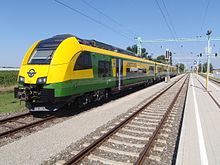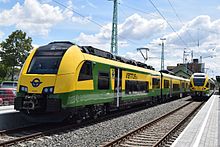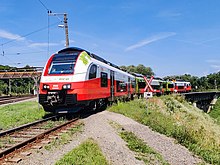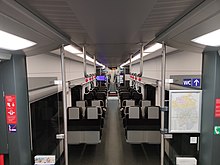ÖBB / Raaberbahn / ODEG 4744/4746
| ÖBB 4744 and 4746, Raaberbahn 4744, ODEG 4746 | |
|---|---|
| Number: | Rh ÖBB 4744: 70 Rh GYSEV 4744: 5 Rh ÖBB 4746: 95 (+35) Rh GYSEV 4746: 3 ODEG 4746: 7 |
| Manufacturer: | Siemens Mobility |
| Year of construction (s): | 2015– |
| Axis formula : | Bo'Bo '+ 2'2' + Bo'Bo ' |
| Gauge : | 1435 mm ( standard gauge ) |
| Length over coupling: | 75,152 mm |
| Trunnion Distance: | 16.24 m |
| Bogie axle base: | 2,300 mm |
| Empty mass: | 145 t |
| Wheel set mass : | <17 t |
| Top speed: | 160 km / h |
| Hourly output : | 2600 kW |
| Acceleration: | 1.1 m / s² |
| Power system : | 15 kV 16.7 Hz ~ 25 kV, 50 Hz ~ |
| Power transmission: | Overhead line |
| Seats: | ET 4744: maximum 259 ET 4746: maximum 244 |
| Floor height: | 600 mm above SoK |
The series 4744 and 4746 of the Austrian Federal Railways and the Raaberbahn as well as the series 4746 of the East German Railway are electric railcars that have been delivered by the manufacturer Siemens Mobility since December 2015 . They were also known under the name ÖBB Cityjet or Raaberbahn Ventus ( proper spelling cityjet or ventus ), as they represent the first vehicles in the new local public transport corporate design of ÖBB, which is called "Cityjet". Although the trains are operated by different RUs, they are exactly the same. The GYSEV series 4744 even received the Austria seats developed for ÖBB (Borcad GENIO).
The 4744 series was developed for regional traffic and S-Bahn systems outside of Vienna and the 4746 series for operation with the Vienna S-Bahn , the latter has two more doors per side. Although intended for use in Germany, the multiple units leased by ODEG also belong to the 4746 series.
vehicles
The series 4744 and 4746 belong to the Desiro ML type of the Desiro platforms developed by the manufacturer Siemens Mobility .
The 78 regional trains supplied (70 for ÖBB and 5 for Raaberbahn ) of the 4744 series offer 259 seats and four boarding areas, corresponding to four doors on each side of the train. The 31 series 4746 S-Bahn trains delivered from 2015 have 244 seats with six boarding areas, corresponding to six doors on each side of the train, and are intended for high-speed traffic in metropolitan areas such as Vienna . Both three-part multiple unit rows reach a top speed of 160 km / h with both types of high voltage and can be driven in multiple traction. The trains are fully air-conditioned.
The facilities include a handicapped accessible and a standard on- board toilet . The passenger area is equipped with daytime-controlled lighting, folding tables and adjustable seats. The regional trains offer three, the S-Bahn two multi-purpose areas, e.g. for bicycles. In addition, all vehicles are equipped with sliding steps for platforms with a height of 550 mm at the ends of the train and 380 mm at all entrances, with the sliding steps being extended to a height of 380 mm for platforms with a height of 200 mm.
Cityjets have been gradually being equipped with WiFi since 2017 . Individual seats are also being removed in order to speed up passenger changes. Access to ÖBB Railnet Regio is possible via WLAN. Railnet Regio enables access to the online version of some newspapers and magazines as well as to ORF TVthek. Furthermore, information about the journey is conveyed (for example: the current position of the train).
history

In April 2010, a framework agreement was reached between the manufacturer and ÖBB for the delivery of up to 200 Desiro ML sets. The agreement also includes an option for the maintenance of the multiple units, resulting in a total order volume of around one billion euros. These locomotives should be available as needed by 2015, on the one hand to replace the old sets of the 119 series 4020 on the Wiener Schnellbahn and the total of 143 CRD push-pull trains in regional traffic (new generation domestic cars) and, on the other hand, to possibly to strengthen the local network to be operated between Salzburg , Kufstein and Munich and the area of the Werdenfels network. However, in the meantime, Deutsche Bahn has won the tender for the Werdenfels network, which operates it with Bombardier Talent 2 vehicles .
At the Supervisory Board meeting of the ÖBB on January 30, 2013, it was decided to order the first call of 100 trains worth 550 million euros from the framework agreement. The plans envisage delivery from the end of 2015.
The production of some of the first multiple units takes place in the Siemens plant in Krefeld-Uerdingen , the majority of other trains in the ÖBB plant in the Jedlersdorf district of Vienna. All SF6000 bogies are manufactured at the Siemens location in Graz .
It was later decided to order an additional 101st Cityjet with the number 4746.031, which serves as a replacement for the ÖBB 4024 series that was irreparably damaged in the accident in Vienna-Penzing .
In February 2014 the Raaberbahn announced that it had also ordered Siemens Desiro ML railcars . On July 15, 2016, the first class 4744 multiple unit (GYSEV 4744 300) was presented. This is called ventus by GYSEV . The Ventus multiple units could possibly be taken over by another railway company in 2019 if the Vienna – Ebenfurth route is passed on to another operator.
In December 2016, ÖBB ordered a further 64 Desiro ML in the S-Bahn version with delivery by the end of 2019. The vehicles of the 4746 series are to completely replace the 4020 series. A total of 165 Desiro ML sets will operate. The reconditioning of the sets 4744, which have been involved in accidents since their commissioning, was only partially carried out (as of May 2018). The 4744 022, which was damaged in Kritzendorf in December 2017, was put back into operation, the 4744 054 set, which had an accident in Niklasdorf in February 2018, was reconditioned and has been in passenger service on the Styrian S-Bahn since spring 2020.
The first two sets have been equipped with free WiFi since December 2016. In trial operation, they were mainly used on the Franz-Josefs-Bahn. Due to the positive response, the remaining sets have also been equipped with it since July 2017.
As the ÖBB announced in a promotional video about the Desiro ML Cityjet, the regional train variant with six doors (4746 series) will be used as planned in Carinthia and East Tyrol from December 2017. Also with the 2017/18 timetable change, railcars of the 4744 and 4746 series will be used as planned on the Salzburg S-Bahn.
In 2019 and 2020 further reorders followed by the ÖBB and the Raaberbahn. In 2019, ÖBB ordered a further 24 trains and the Raaberbahn ordered three trains of the 4746 series and at the beginning of 2020, ÖBB ordered eleven more trains of the 4746 series. These trains are scheduled to go into operation between summer 2020 and the end of 2021. The 35 ÖBB trains will be given a reinforced intermediate car, which allows the subsequent installation of batteries on the roof so that the trains can also be used on non-electrified routes. With the last order from ÖBB in January 2020, the framework agreement concluded in 2010 for 200 Desiros ML was fully exhausted.
Operation in planned traffic since December 2015



With the timetable change on December 13, 2015, passenger use of the new trains began with two plantations on the S80 line. Since January 11, 2016, a railcar has also been used on the Styrian S-Bahn lines S1 and S5 . 4746 002 has also been in the Linz area since the beginning of January 2016, where it was primarily used for staff training, but was also repeatedly seen in passenger service. On February 11, 2016, the scheduled use on the Vienna trunk line began . Since that date, a tandem team has been traveling on lines S2 and S7 between Laa an der Thaya, Mistelbach, Wolkersdorf or Floridsdorf and Vienna Airport, Wolfsthal, Vienna Meidling and Mödling.
In Vienna, at the beginning of 2016, some sets were also used on the S2 and S7 lines, which are linked by circulation. With the ongoing delivery of new sets in 2016, the 4744 series (four-door variant) was also used for the first time, and the six-door sets were mostly returned to the eastern region by the end of 2017.
All five Ventus trains have been in operation on the route between Vienna Central Station and Deutschkreutz as well as between Vienna Central Station and Pamhagen since September 2016 and have since replaced some of the 4124 class railcars . Ventus railcars are also used on the Vienna Hauptbahnhof – Bratislava – Petržalka route. In rare cases, trains from the 4744 and 4746 series are also used by ÖBB on the Neusiedlerseebahn and on the route between Deutschkreutz and Bratislava-Petržalka.
In the course of 2016, S-Bahn lines 2 and 7 in eastern Austria were always circulated on Desiro MLs and, from the turn of the year 2016/2017, the first regional traffic of the 4744/4746 on the Franz-Josefs-Bahn and on the Westbahn followed between St. Pölten and Pöchlarn. In September 2017, the majority of the Cityshuttle wagons were displaced in electrically powered local transport in the VOR area. In Upper Austria, the deployment has also been extended to almost all electrically operated ÖBB routes and in Styria the Desiros are being used as planned in mixed operation with Talent 1 and the Cityshuttle sets on S-Bahn lines 1, 5, 8 and 9.
On Friday, December 8th, 2017, the long-distance wagons of the former REX 200 (now REX PLUS, as the maximum speed of the 4744 is limited to 160 km / h) were replaced by the 4744 series. This is the first scheduled operation on a route that is equipped with ETCS , as the trains between Wien Hütteldorf and St. Pölten HBF run on the new line through Tullnerfeld.
The second series of railcars 4746 032 and 033 have been in regular passenger service since February 22, 2018.
Cityjet eco
In September 2018, ÖBB and Siemens presented the 4746 049 set in an eco version with an electro-hybrid drive. The intermediate car has accumulators on the roof that can be charged while driving under the overhead contact line and thus also enable journeys on non-electrified routes. The accumulators with a capacity of 528 kWh feed the electrical energy via two two- quadrant controllers into the DC link of the traction converter. The railcar can be accelerated to up to 100 km / h with a reduced starting acceleration of 0.77 m / s². (In overhead line operation: 1.0 m / s² or 140 km / h.) On September 2, 2019, the passenger deployment test operation began.
Announcements
The ÖBB and the Raaberbahn decided to announce all stations three times in the vehicles of the 4744 and 4746 series. When the train leaves, the announcement “Train to: destination station . Next stop: next stop of the train and special information such as B. Level difference ". Shortly before reaching the station, the announcement is made: "We will shortly reach: next stop of the train and special information such as level difference ". When a stop is reached, the announcement sounds: "Station: Current station and special information such as. B. Level difference , exit in the direction of travel: left / right ”. All announcements, including those in the Raaberbahn's ventus railcars, are spoken by Chris Lohner .
Another innovation, which was introduced with the use of the 4744 and 4746 series on the Vienna FJBf – Gmünd – České Velenice line since December 2016, was that the place name of České Velenice was now taken from Danuše Hostinská-Klichová, the announcer of the České dráhy , is spoken. The first of the three announcements with the end of the train station in each of the trains to České Velenice sounds as follows: “Train to [spoken by Chris Lohner]: České Velenice [spoken by Danuše Hostinská-Klichová]. Next stop: next stop of the train and special information such as B. Connections [spoken by Chris Lohner] ".
The Raaberbahn started a similar attempt in the first quarter of 2017. At the beginning, the text excerpts “next stop” and “we will be there shortly” were carried out by a Hungarian speaker in German. The section “Train to:” was completely omitted. Afterwards, it was tried for a short time to read the text excerpts mentioned in both German and English. The announcements became considerably longer, however, as all special information was announced both at the destination station and at the next stop, and then again with the English excerpts. It was then decided in July 2017 to align the announcements with those of the ÖBB. So now everything - except the train station in České Velenice [spoken by Danuše Hostinská-Klichová] - is spoken by Chris Lohner and the special information from the announcement of the destination station has been removed.
Since February 25, 2019, the announcements in the Desiro ML of the ÖBB have also been spoken in English, but after a few weeks this was again marked as pointless due to the length of the announcements. In the meantime, almost all railcars have been reprogrammed to exclusively German announcements. Only a few sets have not yet passed this provision.
Operational area ÖBB and Raaberbahn
| line | course |
|---|---|
| Graz Hbf - Peggau - Deutschfeistritz - Frohnleiten - Bruck an der Mur | |
| Graz Hbf - Spielfeld-Straß | |
|
|
( Friesach -) Unzmarkt - Leoben Hbf - Bruck an der Mur |
| Bruck an der Mur - Kapfenberg - Mürzzuschlag | |
| Graz Hbf - Selzthal (- Schladming) | |
| Lienz - Friesach | |
| St. Veit an der Glan - Rosenbach | |
|
|
Villach Hbf - Arnoldstein - Hermagor |
| line | course |
|---|---|
| Linz Hbf - Enns - St. Valentin - Steyr - Garsten (- Kleinreifling or Weissenbach-St. Gallen) | |
| Linz Hbf - Wels Hbf (sometimes further thanREX/ R to Salzburg Hbf / Freilassing ) | |
| Linz central station - Pregarten (- Summerau) | |
| Linz Hbf - Traun - Kremsmünster - Kirchdorf an der Krems | |
| Linz Hbf - Traun - Kirchdorf an der Krems - Windischgarsten - Spital am Pyhrn (- Selzthal ) | |
| Linz Hbf - Attnang Puchheim - Obertraun-Dachsteinhöhlen - Stainach-Irdning | |
| Linz Hbf - Wels Hbf - Passau Hbf | |
|
|
Salzburg Hbf - Golling-Abtenau - Bischofshofen - Schwarzach-St.Veit - Saalfelden - Wörgl Hbf |
| line | course |
|---|---|
| Vienna Hbf - Gramatneusiedl - Bruck an der Leitha (individual services) | |
| REX R. | Bratislava-Petržalka - Bruck an der Leitha - Vienna Hbf - Vienna Meidling - Ebenfurth - Wulkaprodersdorf - Sopron - Deutschkreutz |
| REX R. | Pamhagen - Neusiedl am See - Parndorf - Bruck an der Leitha - Vienna main station |
ODEG series 4746
In 2019, the Ostdeutsche Eisenbahn GmbH (ODEG) decided to procure new vehicles with a view to possible use on the Ostseeküste-Ost sub- network of the Mecklenburg-Western Pomerania transport company . To this end, Alpha Trains ordered seven four-part Desiro ML multiple units from Siemens Mobility, which were leased to ODEG . According to information from the Austrian Federal Railways, a joint order was placed in 2019, with the order from the ODEG, the ÖBB saves a seven-digit euro amount on its order for 24 multiple units. In return, a lease of six ÖBB class 4746 railcars to ODEG for four months was agreed so that the ODEG could ensure the operation of the regional express lines from December 15, 2019. This affected multiple units 4746 051 to 056.
The first multiple unit went through the commissioning phase in December 2019. The first ODEG railcar (A-ODEG 94 81 4746 301-2) was accepted at the end of January 2020 and shortly afterwards went into passenger service. Since the vehicles are from ongoing production for ÖBB, they will initially be delivered in three parts; an extension to four vehicles shortly after delivery was agreed with the order. Like all vehicles of the 4746 series, the multiple units have been fitted with equipment for operation under 25 kV, 50 Hz ~ and 15 kV, 16.7 Hz ~.
The interior equipment corresponds to that of the ÖBB vehicles. The seats of the type Borcad GENIO are, however, kept in one color in gray.
| line | course |
|---|---|
| RE 9 | Rostock - Ribnitz-Damgarten - Velgast - Stralsund - Bergen - Lietzow - Sassnitz / Ostseebad Binz |
| RE 10 | ( Rostock - Ribnitz-Damgarten - Velgast -) Stralsund - Greifswald - Züssow |
Web links
literature
- Markus Inderst : ÖBB Cityjet family (ÖBB series 4744 and 4746) . In: Modellbahnwelt . No. 3 , 2017, p. 16-23 .
Individual evidence
- ↑ http://www.borcad.cz/en/portfolio/genio-eng/
- ↑ Presentation of the Desiro ML for ÖBB of the manufacturer ; accessed on May 13, 2015 (PDF)
- ↑ Railnet Regio - WLAN, service & infotainment in the Cityjet. In: oebb.at. ÖBB, accessed on February 13, 2018 .
- ↑ Environmentally friendly trains for Austria: Siemens concludes framework agreement with ÖBB . Press release, April 20, 2010. Website of Siemens AG. Retrieved May 13, 2015 (PDF)
- ↑ Friedhelm Weidelich: ÖBB orders Desiro ML from Siemens ( Memento from August 12, 2016 in the Internet Archive ) . RAILoMOTIVE blog, April 20, 2010. Accessed May 13, 2015
- ↑ Dirk Walter: Werdenfels-Takt: New DB Age from 2013 , In: merkur-online.de , June 28, 2010. Accessed on May 13, 2015
- ↑ Press release from the manufacturer of January 30, 2013: ÖBB wants to order the first 100 regional trains for 550 million euros ; accessed on May 13, 2015 (PDF)
- ↑ Presentation of the ventus ; accessed on July 16, 2016
- ↑ 70 + 31 +64 = 165
- ↑ Starting signal for 64 new city jets in local transport. In: ots.at. BMVIT / ÖBB, December 15, 2016, accessed on January 7, 2017 .
- ↑ Cityjet: The modern local and regional train. In: youtube.com. Retrieved July 12, 2017 .
- ↑ Bernhard Rieder: ÖBB: Lots of news in the east - 24 more Cityjet Desiro ML ordered for local and regional traffic. In: ÖBB. March 12, 2019, accessed January 10, 2020 .
- ↑ Angelika Illedits: Three new trains for local traffic - The Raaberbahn celebrated in Neufeld. My district, December 12, 2019, accessed January 10, 2020 .
- ↑ https://www.lok-report.de/news/europa/item/15828-oesterreich-oebb-bestellt-elf-neue-desiro-ml-bei-siemens-mobility.html. In: Lok Report. Lokomotive Fachbuchhandlung GmbH, January 31, 2020, accessed on January 31, 2020 .
- ↑ Kleinezeitung.at of January 11, 2016: Cityjet between Spielfeld and Graz - quick route to Graz ; accessed on February 13, 2016
- ↑ https://presse.oebb.at/de/presseinformationen/20180910%E2%80%93PI%E2%80%93PV%E2%80%93 Presentation of ÖBB press information
- ↑ Desiro ML ÖBB Cityjet eco for ÖBB-Personenverkehr AG. Siemens Mobilty, accessed September 3, 2019 .
- ↑ "Prototype ÖBB Cityjet eco celebrates its premiere in passenger operation" blog.oebb.at, accessed on September 2, 2019.
- ↑ a b Alpha Trains orders regional trains for Mecklenburg-Western Pomerania , Siemens Mobility press release, December 16, 2019
- ↑ Old vehicles for Austria, new ones for Germany? , blog.oebb.at, accessed on February 22, 2020
- ↑ Tim Schulz: Proven platform . In: regional traffic . tape 23 , no. 2 , March 2020, ISSN 1615-7281 , p. 14-16 .
- ↑ ODEG-Desiro ML on the go , lok-report.de, February 13, 2020
- ↑ Desiro Mainline EMUs For ODEG , railvolution.net, December 16, 2019 (English)
- ↑ Photo of the interior of an ODEG class 4746 multiple unit








